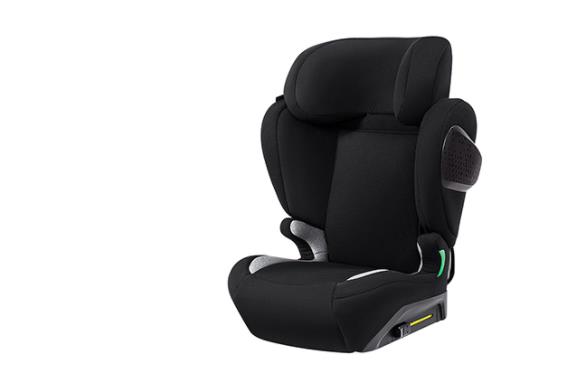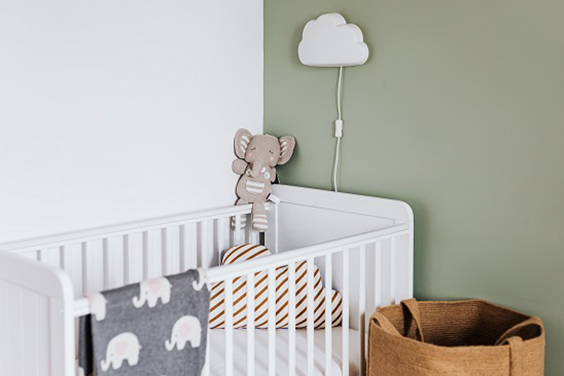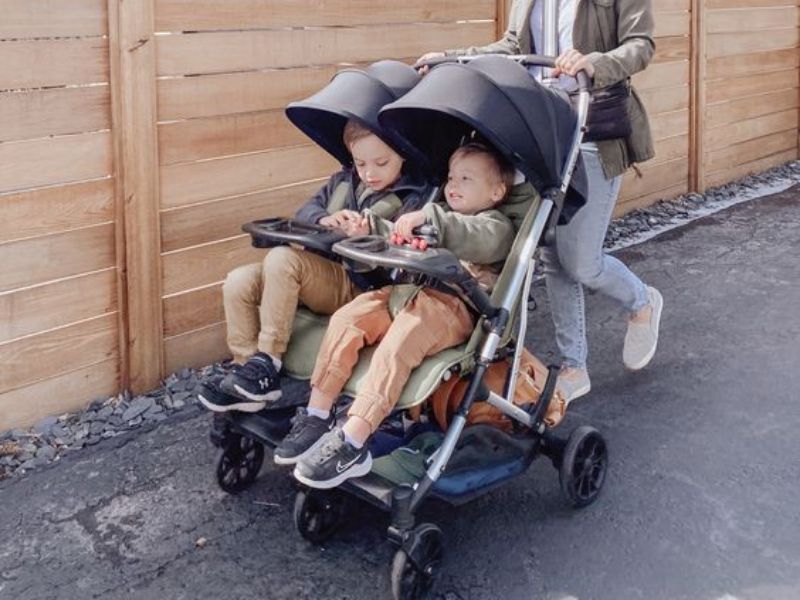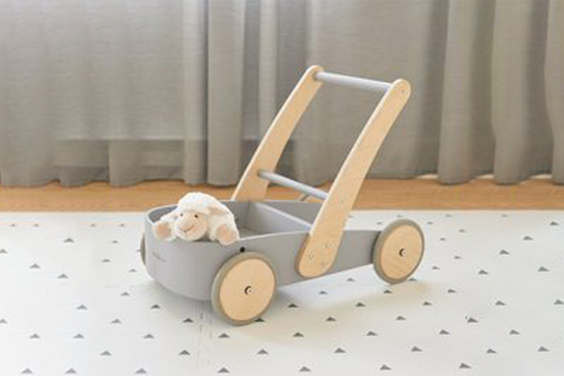Getting ready for a baby is such a thrill! This phase is all about dreams, happiness, and… decisions. A big task ahead is finding the right bed for your little one. Just think; they’ll be spending lots of time there, both sleeping and playing. It’s more than just wood and screws; it’s their cozy corner.
But here’s a tip: Cribs come in all shapes and qualities. Some last longer, some are built with extra safety, and others have cute design. With choices like the Davinci Kalani or any others, how do you decide? That’s where our guide steps in! We’ll help you understand safety and design, making it easier to pick. It’s all about ensuring you and your baby are content.
Key Features to Consider When Buying the Best Cribs
So, you’re ready to buy a crib. Awesome! But hold your horses. Before you click that “Buy Now” button on Amazon or head to Pottery Barn, let’s talk about some key features you should consider.
Mattress Height
First off, the mattress height is a biggie. Adjustable mattress heights are a godsend, especially as your baby grows. You don’t want to be bending over too far to pick up your newborn, but you also don’t want your toddler climbing out easily as they grow.
Convertibility
Next up, is convertibility. A 4-in-1 convertible crib can be a real lifesaver. It can transform from a crib to a toddler bed, then a daybed, and even a full-size bed. Talk about getting more bang for your buck!
Storage Space
Who doesn’t need more storage space? Some cribs come with built-in drawers, which can be super handy for storing bedding, diapers, or those cute little outfits you just can’t resist buying.
Safety Features
Last but definitely not least, safety features are paramount. Look for cribs that meet the Consumer Product Safety Commission standards. Features like sturdy slats and safety certifications can make all the difference.
Phew! That’s a lot to take in, but don’t worry, we’re just getting started. Up next, we’ll dive into safety certifications, because let’s face it, nothing is more important than keeping your little one safe and sound.
What Safety Certifications Should I Look For When Buying a Crib?
When it comes to your baby’s safety, you really can’t cut corners. It’s not just about picking a crib that looks good or fits well in your nursery. The safety certifications are where the rubber meets the road. So, what are these magical seals of approval you should be looking for?
Greenguard Gold Certified
First up, Greenguard Gold Certification. This isn’t just some random sticker they slap on the box; it’s a rigorous testing process that ensures the crib is low in chemical emissions. In simpler terms, it means the air around the crib is cleaner and safer for your baby to breathe. This is especially important for newborns, who are more susceptible to respiratory issues.
American Academy of Pediatrics (AAP)
Another biggie is the American Academy of Pediatrics. If a crib has their endorsement, you’re on the right track. The AAP is a leading authority on child health and well-being, so their recommendations carry a lot of weight. They often collaborate with pediatricians to ensure that products meet the highest safety standards, focusing on reducing risks like Sudden Infant Death Syndrome (SIDS).
Consumer Product Safety Commission (CPSC)
You’ll also want to make sure the crib meets or exceeds the standards set by the Consumer Product Safety Commission (CPSC). They’re the federal agency responsible for protecting the public from unreasonable risks of injury or death from consumer products. If a crib has its certification, it means it has passed a series of rigorous tests for safety and durability.
Additional Certifications
Extra Approvals Certain cribs have more than just the basic stamps of approval, such as a nod from the Juvenile Products Makers Group (JPMA). This gives you added confidence that the crib underwent checks for its durability and safety.
User Comments and Tester Responses
Never overlook the value of user comments and evaluator responses. They offer genuine perspectives on a crib’s safety and sturdiness. Search for comments that highlight the crib’s protective aspects and interactions with the brand’s support, revealing the brand’s dedication to safety. Regarding safety stamps, the more, the merrier.
The more approvals a crib has, the more reassuring it is. While no item promises absolute safety, opting for a crib with several stamps of approval can notably lessen concerns and offer more comfort. After all, restful sleep is invaluable for both your little one and you.
What Materials Are Best for Durability and Longevity in Cribs?
When you’re investing in a crib, you’re not just looking for a temporary fixture. You want something that’ll stand the test of time, endure those toddler years, and maybe even serve future siblings. So, what materials should you be eyeing?
| Material Type | Description |
| Solid Wood | Often made from types like New Zealand Pine, solid wood is sturdy, durable, and timeless. It’s heavier and less likely to tip over. Higher price point but offers longevity. |
| Plywood and Composite Woods | Budget-friendly but may lack the durability of solid wood. Ensure they are high quality and free from harmful chemicals. |
| Metal Cribs | Made from iron or steel, these cribs offer modern design and durability. Easy to clean and long-lasting. Ensure the paint or finish is non-toxic. |
| Sustainability Matters | Look for cribs made from sustainable materials or those with eco-friendly certifications. Safer for the baby and better for the planet. |
Best Cribs for Small Spaces: Maximizing Nursery Real Estate
Not everyone has the luxury of a sprawling room for their baby. Space is often a luxury, especially in urban settings. But just because your nursery is on the smaller side doesn’t mean you have to compromise on quality or style.
Mini Cribs: Big on Benefits
Mini cribs are a godsend for small spaces. They’re compact, often portable, and can fit snugly even in tight corners. Plus, many of them are convertible, meaning they can transform into toddler beds as your child grows.
Multi-functional Cribs: More Than Just a Bed
Some cribs are designed to serve multiple purposes. They might come with attached changing tables, drawers, or even shelves. This means you’re getting multiple pieces of furniture in one, saving space and money.
Wall-mounted and Foldable Options
Innovation in crib design has led to wall-mounted or foldable cribs. These can be folded or tucked away when not in use, freeing up valuable floor space. They’re especially handy if your baby often stays at your grandparents’ or if you travel frequently.
Your nursery’s size shouldn’t limit your choices. With a bit of research and some smart decisions, you can have a functional, stylish, and safe space for your baby, no matter how limited the square footage is.
Design Highlights: Top Trendy Cribs for 2023
Your little one’s crib is more than just practical; it’s a style declaration. And 2023’s design highlights offer a plethora of options.
- Simplicity: Embracing the Basics The simplicity trend emphasizes straightforwardness and purpose. Envision neat structures, muted shades, and tidy looks. Brands such as Babyletto Hudson champion this style with their refined models.
- Classic Comeback: Cherishing the Past There’s an enduring charm to classic styles. Cribs featuring spindle supports, intricate elements, and ageless coatings are resurfacing. They infuse a hint of yesteryears into today’s baby rooms.
- Vivid and Striking: Stand-Out Choices For the daring at heart, cribs in standout shades and unique patterns are the rage. Ranging from rich navy tones to bright sunshines, these cribs are bound to be the focal point in any baby space.
- Tailored Styles: Add Your Flair Certain brands present tailored styles, letting parents select shades, and coatings, or even infuse individual elements. It’s about crafting a crib that’s distinctively yours.
12 Best Baby Cribs This Year
When it comes to cribs, brand reputation matters. Here are some of the top contenders in 2023:
River Baby
Special Features: Made of aluminum with a protective coating, ensuring durability and lightweight design. Comes with a drop-side function, making it easier for parents to access their baby. Offers 6 height portions, ensuring the playpen grows with the baby.
Pros:
- Versatility: Suitable for babies aged 0-9 months, ensuring it meets the needs of growing infants.
- Durability: The aluminum frame with coating promises longevity.
- Convenience: The removable fabric, drop side function, and multiple adjustable features make it user-friendly for parents.
- Mobility: The mute wheel with stopper ensures the playpen can be moved around easily and stays in place when needed.
- Storage: Comes with both a regular and a large basket, providing ample storage space for baby essentials.
Dream On Me Aden 4-in-1 Convertible Crib
Special Features: The Dream On Me Aden offers a 4-in-1 convertibility feature, allowing it to transform from a crib to a daybed, toddler bed, and eventually a full-size bed. Made of solid pine wood, it promises durability. Its design is both modern and timeless, ensuring it fits various nursery themes.
Pros: Its versatility means it can grow with the child, providing value for money. The solid pine wood construction ensures longevity and sturdiness, making it a safe choice for parents.
Lotus Travel Crib
Special Features: Designed for the traveling family, the Lotus Travel Crib is lightweight and easily foldable. It comes with a backpack for easy transport. The crib boasts GreenGuard Gold Certification, ensuring safety standards. Its mesh sides promote breathability and visibility.
Pros: Perfect for on-the-go families, it’s easy to set up and dismantle. The mesh sides ensure parents can always have a clear view of their baby, and the certification guarantees safe materials are used.
Pottery Barn Kids Babyletto Hudson 3-in-1 Convertible Crib
Special Features: This crib offers 3-in-1 convertibility, transitioning from a crib to a toddler bed and daybed. Made with sustainable New Zealand pine wood, it’s eco-friendly. Additionally, it’s GreenGuard Gold Certified, ensuring low chemical emissions.
Pros: Its stylish design makes it a favorite among modern parents. The use of sustainable materials and safety certifications make it both eco-friendly and baby-friendly.
West Elm Kids Mid-Century Painted Convertible Crib
Special Features: This crib boasts a mid-century modern design, offering a blend of vintage and contemporary aesthetics. It can convert from a crib to a toddler bed, ensuring prolonged use.
Pros: Its design is both stylish and functional, fitting well in contemporary homes. The convertibility feature ensures parents get value for their money as the child grows.
Dream On Me Bellport 4-in-1 Convertible Mini/Portable Crib
Special Features: This multi-functional crib can serve as a mini crib, changing station, playpen, and twin bed. Its portability ensures it can be moved around the home with ease.
Pros: The Bellport offers multiple uses, making it a versatile choice for parents. Its compact design is perfect for smaller spaces or for parents who prefer a minimalist approach.
Simmons Kids’ Slumbertime Monterey 4-in-1 Convertible Crib
Special Features: This crib offers 4-in-1 convertibility, ensuring it grows with the child. Made of sustainable wood, it promises durability and longevity.
Pros: Its classic design ensures it never goes out of style. The durable construction guarantees safety and longevity, making it a wise investment.
Hudson 3-in-1 Convertible Crib
Special Features: Similar to the Babyletto Hudson, this crib offers 3-in-1 convertibility. It’s also GreenGuard Gold Certified, ensuring it meets strict chemical emission standards.
Pros: Its modern design is both stylish and functional. The certification ensures it’s made of safe materials, giving parents peace of mind.
SNIGLAR
Special Features: Made of solid beech wood, the SNIGLAR crib offers a minimalist and functional design. Its simplicity ensures it fits in various nursery themes.
Pros: Its affordability doesn’t compromise on quality. The solid beech wood ensures durability, and its simple design is both functional and aesthetically pleasing.
Winston 4-in-1 Convertible Crib
Special Features: The Winston crib offers 4-in-1 convertibility, ensuring long-term use. Its design is both elegant and timeless.
Pros: Its versatility ensures it grows with the child, offering value for money. The elegant design ensures it’s a centerpiece in any nursery.
Simmons Kids Asher 6
Special Features: Details about its convertibility are not specified, but given the brand’s reputation, it’s likely made of high-quality materials and offers some level of convertibility.
Pros: Simmons is known for its durable and high-quality cribs. The Asher 6, with its classic design, is likely no exception, promising both style and functionality.
DaVinci Jenny Lind Crib
Special Features: This crib boasts a vintage spindle design that’s both iconic and timeless. Made of sustainable New Zealand pine, it’s eco-friendly. Additionally, it’s GreenGuard Gold Certified.
Pros: Its design is both nostalgic and stylish, making it a favorite among parents who appreciate vintage aesthetics. The use of sustainable materials and safety certifications adds to its appeal.
How to Choose the Best Crib for Your Baby
Picking the right crib for your little one requires a thorough look at multiple aspects. It’s more than just style or brand; it’s about ensuring a safe, cozy, and apt space for your baby. Here’s what to keep in mind:
- Safety Checks: Top priority. Make sure the crib adheres to essential safety guidelines, like those from the CPSC, AAP, and other key bodies. Cribs with Greenguard Gold tags are great for low chemical outputs.
- Mattress Firmness: The mattress base should be robust. Metal bases often outlast wooden ones. Also, the mattress should fit tightly, leaving no side gaps.
- Height Flexibility: Being able to adjust the mattress height is useful, especially as your baby grows.
- Growth-Friendly Design: Convertible cribs are budget-smart as they adapt with your child, transitioning from a crib to various bed types.
- Gum Protectors: Teething rails can be beneficial. They shield the crib’s edges and your baby’s gums during teething phases.
- Mobility Features: If the crib has wheels, it’s easier to shift. Just ensure they lock to stabilize the crib.
- Style Points: Beyond safety and use, you’d want a crib that matches your nursery’s vibe. Think design, shade, and overall look.
- Price Point: Cribs vary in cost, from economical to luxury. Set a budget and hunt for the best bang for your buck.
- Brand Credibility: Gauge the brand’s track record in quality, safety, and customer relations. Check out reviews and ask peers.
- Setup Simplicity: Some cribs are simpler to put together. Think about the setup steps and if you’d need extra hands.
- Green Choices: If you lean green, eye cribs crafted from earth-friendly materials and harmless coatings.
- Bonus Traits: Ponder over extra perks you might value, like integrated storage, an attached changing spot, or a decorative canopy. In essence, selecting your baby’s crib is about balancing safety, utility, style, and cost-effectiveness. With the vast choices in 2023, you’re bound to spot a crib that meets your criteria.
The Importance of Mattress Fit and Crib Adjustability
Why Mattress Size and Crib Flexibility Matter For your baby’s crib, ensuring the right mattress size and flexibility is vital for safety and coziness. Here’s the breakdown:
- Mattress Size: A tight mattress fit is key for baby safety. Loose-fitting mattresses can lead to gaps, which might trap a baby, increasing suffocation hazards. Always double-check crib and mattress sizes before buying.
- Height Flexibility: Cribs that let you change mattress heights are great since they adapt as your child grows. For tiny ones, a raised mattress is more accessible. As they grow and move more, lowering the mattress stops them from trying to climb.
- Two-Faced Mattresses: Some mattresses come with two sides: a harder one for babies and a softer one for toddlers. This design can make the mattress last longer, suiting your child’s growth phases.
- Composition and Sturdiness: Mattress material matters. Foam ones are light and user-friendly, while spring-based ones last longer but weigh more. For babies, always opt for a sturdy mattress to minimize Sudden Infant Death Syndrome (SIDS) risks.
- Air Flow: Mattresses that allow air to flow can help keep a steady temperature, ensuring your baby’s comfort and reducing overheating dangers.
- Spill-Proof and Cleanable: Mishaps occur, so having a spill-proof or easily cleaned mattress cover aids in tidying up and stops mold or germ buildup.
- Safety Tags: Seek mattresses with safety tags, like Greenguard Gold, indicating fewer chemical releases.
- Flexibility Extras: Some newer cribs offer more flexibility perks, like tilt options for reflux-prone babies or remote height changes, giving parents added ease. Choosing the right mattress size and crib flexibility isn’t just about coziness; it’s a safety must-have. By focusing on these aspects, you ensure a sleeping spot that’s safe and evolves with your child’s needs.
What Accessories or Add-Ons Are Worth Considering When Purchasing a Crib?
When shopping for a crib, you’ll often come across various accessories and add-ons that promise to enhance the crib’s functionality or aesthetic appeal. But which of these are truly worth considering? Let’s delve into some of the most popular and useful crib accessories:
- Hanging Toys: These are fun decorations that dangle over the crib and often have soft toys, lights, or tunes. They can entertain and calm your baby, but make sure they’re well-secured and out of reach.
- Built-In Storage: Some cribs have drawers or shelves, which are great for keeping baby stuff like diapers and blankets. This is super useful if you’re tight on space.
- Chew Guards: As babies get older, they might chew on the crib sides to help with teething. Chew guards protect the wood and give your baby a safe place to gnaw.
- Decorative Skirts: These add a fancy touch and can also hide storage bins under the crib.
- Overhead Covers: If you want to make the crib look extra special, an overhead cover can do the trick. Just make sure it’s safely attached and not a hazard.
- Soft Barriers: Once used to keep babies from bumping into crib sides, these are now mostly discouraged because they can be risky. If you still want them, go for breathable mesh types.
- Mattress Covers: These give an extra layer of comfort and can protect against spills or leaks.
- Rolling Options: If your crib doesn’t have wheels, some brands sell them separately. They’re handy for moving the crib, but make sure they lock securely.
- Growth Kits: If you have a crib that can change into a bigger bed, you might need an extra kit to make the switch.
- Safety Nets: These stop older kids from climbing out but use them carefully. Make sure they’re safe and have good air flow.
- Sleep Aids: Things like nightlights or sound machines can help your baby sleep better. Some new cribs even have these built in.
Remember, while there are lots of extras out there, safety should always come first. Do your homework, read reviews, and check safety rules before adding anything new to your crib.
Common Questions About Choosing the Best Cribs
When it comes to selecting the perfect crib, parents often have a plethora of questions. Addressing these concerns can help in making an informed decision. Here are some of the most frequently asked questions and their answers:
Is it safe to buy a used crib?
While buying second-hand can be cost-effective, it’s essential to ensure the crib meets current safety standards. Older cribs might not adhere to these standards. Always check for recalls and inspect the crib thoroughly for any wear and tear.
How long can my baby use the crib?
Typically, babies can use a crib until they are 2-3 years old or until they start trying to climb out. Convertible cribs, which transform into toddler beds, can be used for several more years.
What’s the difference between a bassinet and a crib?
Bassinets are smaller and designed for newborns up to a few months old. Cribs are larger and built to accommodate babies until they’re toddlers. While bassinets are portable and fit easily beside a parent’s bed, cribs are more of a long-term solution.
Are drop-side cribs safe?
Drop-side cribs have been banned in many countries due to safety concerns. The movable side can malfunction, creating gaps where a baby can get trapped. It’s recommended to avoid these cribs.
How important is the spacing between crib slats?
Very important. The space between slats should be no more than 2 3/8 inches (about 6 cm) to prevent babies from getting their heads stuck.
Do I need a crib if I’m considering co-sleeping?
While many parents opt for co-sleeping, having a crib provides a safe, dedicated space for the baby. It’s especially useful for naps or times when co-sleeping isn’t feasible.
What materials should I look for in a crib?
Look for non-toxic, durable materials. Solid wood, especially from sustainable sources, is a popular choice. Ensure the finish is non-toxic and free from harmful chemicals.
How do I ensure the crib is stable?
Once assembled, give the crib a good shake. It should feel sturdy without any wobbling. Regularly check and tighten any screws or bolts.
Are crib tents and canopies safe?
While they can add aesthetic appeal, it’s essential to ensure they don’t pose a risk of entanglement or suffocation. Always follow safety guidelines if considering these additions.
How often should I check the crib for safety?
Regular inspections, at least monthly, are recommended. Check for loose screws, bolts, or any signs of wear and tear.
Maintenance and Care: Ensuring Your Crib’s Longevity
Investing in a crib is a significant decision, and like any other piece of furniture, its lifespan can be greatly extended with proper care and maintenance. Here’s a comprehensive guide to ensuring your crib stands the test of time:
1. Regular Inspections:
As mentioned earlier, frequent checks are vital. Ensure all screws, bolts, and other hardware are tightly secured. Over time, these can loosen due to the crib’s natural movements.
2. Gentle Cleaning:
Avoid using harsh chemicals on the crib. Instead, opt for mild soap and water or baby-safe cleaning agents. Wipe down the crib regularly to remove dust and prevent the buildup of grime.
3. Address Wear and Tear:
If you notice any chipping paint or splinters, address them immediately. Depending on the crib’s material, you might need to sand and repaint or refinish certain areas.
4. Avoid Overloading Storage Areas:
If your crib comes with built-in storage, be mindful of weight limits. Overloading drawers or shelves can strain the crib’s structure.
5. Rotate the Mattress:
To ensure even wear, rotate the crib mattress every few months. This can prevent sagging and extend the mattress’s life.
6. Protect from Extreme Conditions:
Avoid placing the crib near radiators, heaters, or in direct sunlight. Extreme conditions can warp the wood or fade the finish.
7. Use Teething Guards:
If your baby starts to chew on the crib’s rails, consider using teething guards. These can protect the crib from damage and provide a safe chewing surface for your baby.
8. Follow Assembly Instructions:
When assembling the crib, follow the manufacturer’s instructions to the letter. Incorrect assembly can not only pose safety risks but also affect the crib’s longevity.
9. Mind the Humidity:
Wooden cribs can expand or contract with significant humidity changes. If you live in an area with fluctuating humidity, consider using a humidifier or dehumidifier to maintain consistent levels.
10. Stay Updated on Recalls:
Manufacturers occasionally recall products due to newfound safety concerns. Regularly check for any recalls related to your crib model and address them as advised.
11. Plan for Long-Term Storage:
If you intend to store the crib for future use, disassemble it carefully. Store it in a cool, dry place, and ensure all parts, screws, and assembly instructions are kept together.
In essence, a crib’s longevity is not just about its initial quality but also about the care it receives over the years. With regular maintenance and a proactive approach to care, your crib can serve multiple children and remain a safe and comfortable space for each one.
Summary: Making the Right Choice for Your Child’s Well-being and Relaxation
Selecting the ideal bed for your child involves considering multiple aspects, from security and longevity to aesthetics and flexibility. As discussed in this article, grasping these components can greatly influence your child’s relaxation and health.
In the constantly changing domain of child-related items, it’s vital to associate with firms that emphasize superior quality and also provide adaptability and personalization. This is where brands like River Baby excel. Known for our extensive array of child items, from pushchairs and vehicle seats to feeding chairs and, undoubtedly, children’s beds, River Baby has carved a niche for itself in the market.
What distinguishes us is our strong capability in supply chain collaboration. This expertise enables us to aid different brands in tailoring items to fit distinct requirements, ensuring each bed or child item resonates with the brand’s ethos and quality benchmarks. Additionally, for brands aiming to diversify their product range or amplify their features, River Baby’s OEM service offers a smooth route to product innovation and augmentation.
In the sphere of children’s beds, where security and relaxation are of utmost importance, collaborating with or opting for a brand like River Baby guarantees that caregivers are making a well-informed choice. Our dedication to excellence, coupled with their knack for product customization, ensures every bed is more than just an item but a haven of security and relaxation for your youngster.
As you commence the process of picking the ideal bed, bear in mind the significance of due diligence, comprehending security norms, and partnering with reputable producers. With brands like River Baby at the forefront, caregivers can be confident about their child’s relaxation and security.






